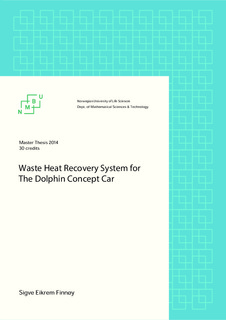| dc.description.abstract | Technological advances in the transportation industry have considerable potential to reduce air pollution and greenhouse gas emissions. Technology deployments, whether in the form of changes in conventional vehicles or through the introduction of radically different vehicle and fuel technologies could give the necessary reduction in greenhouse gas emission for the next several decades.
One of the main engineering tasks today is to gain higher thermal efficiency to conventional power plants already in use. One of the most popular innovative methods of modification involves a gas power cycle on the top of a vapor power cycle. Because the disadvantageous characteristic of a gas turbine cycle exhausting about 60% of its energy, it is possible to take advantage of this high temperature exhaust gases as energy source for a bottoming cycle such as a steam power cycle.
Exhaust heat from a gas turbine can be recovered externally or internally to the cycle itself. Of the technology options for external recovery, the combined gas-steam plant is by far the most effective and commonly used worldwide. For internal recovery conventional solutions are based on thermodynamic regeneration (Preheat of combustion air).
The primary objective in this project was to examine different ways of recovering heat, choose a concept, and to calculate and develop a system design proposal.
First, a Brayton cycle gas turbine from Thue & Sundquist was considered input to this thesis. Second, a Rankine cycle was modeled theoretically with temperature and pressure boundaries from industrial literature to investigate the work output and the thermal efficiency as a function of the maximum pressure and temperature in the steam cycle. All of these relationships were modeled in Microsoft Excel for convenience to do several iterations. A thorough study led to a concept, which was calculated and tested with different inputs. Cost calculations were made for a prototype and series production, and a system solution was proposed.
It was shown in this thesis that a waste heat recovery system (WHRS) has great potential in increasing the overall system efficiency of a gas turbine driven vehicle, and that it is doable concerning space constraints in the Dolphin concept car. It is however many uncertainties realizing a project since this study was done theoretically.
Results that were achieved, with the given input, is that a WHRS adds 21,9kW to the system. That means an increase in overall system efficiency by 19%. The overall system efficiency is now 46%. That is about the same efficiencies you get from a conventional diesel engine.
The calculations were done with several assumptions that cause uncertainties in the result. They were based on the literature study and consultation with GreenTurbine. It is also mentionable that the calculations were done ideally, meaning that losses in components such as friction and heat flux are not considered, except in the steam turbine. Combined it gives a good impression of what to expect in the future when a project is optimized and realized. | nb_NO |
